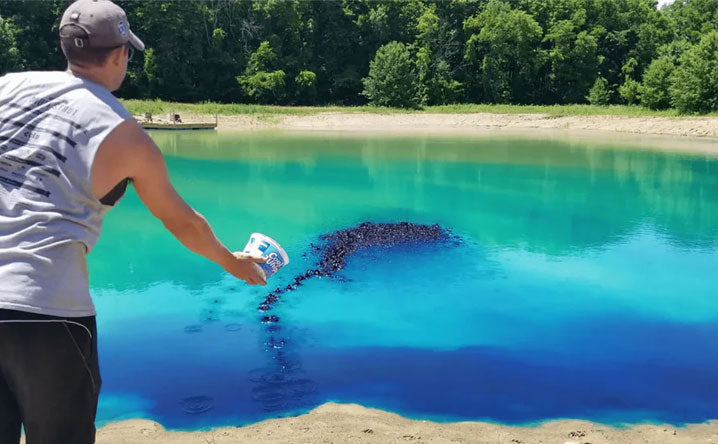Ponds are serene additions to your property and dynamic ecosystems that require careful attention and maintenance. One essential aspect of pond care is choosing the right pond dye color. While it may seem simple, the color you select can significantly impact your pond's health, appearance, and overall appeal.
Understanding Pond Dye
What is Pond Dye?
Before diving into pond dye colors, it's crucial to understand what pond dye is and how it works. Pond dye is a specialized product formulated to add color to the water in your pond. It typically comes in liquid or powder form and is safe for aquatic life. The science behind pond dye offered by experts like Smith Creek Fish Farm involves the absorption and scattering of light. When added to the water, pond dye absorbs specific wavelengths of sunlight while scattering others. This process reduces the amount of light penetrating the water, which has several significant effects.
The Science Behind Pond Dye
- Algae Growth Control: One of the primary benefits of pond dye is its ability to control algae growth. Algae require sunlight for photosynthesis, and by reducing the amount of light reaching the pond's average depth, pond dye inhibits excessive algae proliferation.
- Water Clarity: Pond dye can enhance water clarity by preventing green or murky water formation caused by algal blooms. It creates a pleasing, reflective surface that can mirror the surrounding landscape.
- Temperature Regulation: Pond dye can help regulate water temperature by reducing heat absorption from sunlight, and this can be particularly beneficial in regions with scorching summers, preventing the water from becoming excessively warm.
- Minimizing UV Damage: Sunlight contains harmful ultraviolet (UV) rays that can damage fish and other aquatic life. Beneficial pond bacteria can even be damaged by excessive sunlight. Pond dye is natural sunscreen for your pond inhabitants, protecting them from UV radiation.
- Predatory birds: Pond dye can help prevent predation fron birds such as herrons and king fishers. Pond dye can create a mirrored effect making it more difficult for fish eating birds to capture their prey, especially collorful koi.
Benefits Beyond Aesthetics
While the aesthetic improvement of pond water is undoubtedly appealing, the benefits of pond supplies go far beyond appearance. Let's explore the advantages of using pond dye in more detail.
The Variety of Pond Dye Colors
When it comes to pond dye, you have several color options, from mixed, green, black, or blue dye. Each color serves a specific purpose and can create a unique ambiance in your pond.
Blue Pond Dye
Blue pond dye is a popular choice for many pond owners. It imparts a vibrant blue hue to the water, creating a striking visual contrast with the surrounding greenery. Dark blue, crystal blue, or blue-green dyes are excellent choices for large ponds or recreational activities like swimming in natural settings.
When to Choose Blue Pond Dye:
- If you prefer a picturesque blue pond that complements the landscape.
- For ponds where swimming and aesthetics are equally important.
- In ponds surrounded by lush vegetation, a blue pond dye stands out.
Black Pond Dye
Black pond dye is an intriguing option that transforms your pond into a reflective, dark pool. It gives the water a mysterious and tranquil appearance. Black pond dyes are beneficial in regions with abundant sunlight, as they effectively minimize UV penetration.
When to Choose Black Pond Dye:
- In sunny areas, UV protection and temperature regulation are essential.
- For ponds designed to create a peaceful, mirrored surface.
- If you want to showcase vibrant marginal aquatic plants and trees against a dark backdrop.
Green Pond Dye
Green pond dye mimics the natural color of ponds and lakes. It provides a subtle, earthy tone to the water, making it appear more like a naturally occurring body of water. Green pond dye maintains the pond's natural appearance.
When to Choose Green Pond Dye:
- If you prefer a natural, unaltered look for your pond.
- In ponds, blending seamlessly with the environment is the goal.
- To preserve the ecosystem and wildlife habitat in your pond.
Mixed Pond Dye
Sometimes, choosing a single color doesn't fit your pond's needs. In such cases, you can opt for mixed pond coloring dye, which combines two or more colors to achieve a specific effect. Mixed pond color dye can offer the advantages of multiple colors while allowing for customization.
When to Choose Mixed Pond Dye:
- When you want to combine the benefits of different colors.
- For creating a unique and visually striking pond.
- To address specific water quality or aesthetic goals.
Determining Your Pond's Needs
Now that you're familiar with the variety of pond dye colors available, how do you determine which one is right for your pond? Several factors come into play when making this decision.
Assessing Your Pond
- Size: The size of your pond can influence the choice of pond dye color. Larger ponds may benefit from darker colors like black, which can effectively cover a greater surface area.
- Location: Consider the location of your pond. Ponds in open, sunny areas may require darker pond dye colors to combat excessive UV radiation.
- Surroundings: Take into account the surrounding landscape. A blue or black pond may create a beautiful contrast if your pond nestles within a lush, green environment.
Factors Influencing Color Choice
- Sunlight Exposure: The amount of sunlight your pond receives throughout the day can impact water temperature and algae growth. Choose a color that addresses your specific sunlight conditions.
- Personal Preferences: Ultimately, your personal preferences play a significant role. What visual aesthetic do you want for your pond? Are you aiming for a natural, reflective look or a vibrant blue oasis?
Applying Pond Dye Correctly
Once you've selected the right pond dye color, it's essential to apply it correctly to reap its benefits fully.
Dos and Don'ts
- Do Follow Instructions: Always follow the manufacturer's instructions regarding the proper application and dosage of the pond dye.
- Don't Overdose: Avoid overdosing with pond dye, as excessive use can lead to staining and disrupt the natural balance of your pond.
- Do Apply Evenly: Distribute the pond dye evenly across the pond's surface for quick uniform coloring and effectiveness.
Seasonal Considerations
Keep in mind that the seasons may influence your pond dye needs. For example, during the spring and summer, when sunlight is abundant, you may need to apply more pond dye. Conversely, in the fall and winter, reduce the frequency of application.
The Pros and Cons of Using Pond Dyes
As with any pond care product, pond dyes have pros and cons.
Pros
- Improved Aesthetics: Pond dye enhances the visual appeal of your pond, making it a stunning feature in your landscape.
- Water Quality: By reducing algae growth, pond dye helps maintain better water quality for fish and emergent plants.
- UV Protection: Pond dye is a natural sunscreen that protects aquatic life from harmful UV radiation.
Cons
- Temporary Staining: In some cases, pond dye may temporarily stain rocks or other pond features. However, this staining is usually harmless and fades over time.
- Overuse Risks: Overdosing with pond dye can have adverse effects, such as disrupting the pond's balance.
Unlock the True Potential
Despite these minor drawbacks, the benefits of using pond dye far outweigh the cons, offering a picturesque and thriving aquatic environment.
Conclusion
Choosing the right pond dye color is a decision that goes beyond aesthetics. It influences your pond's health, water quality, and the overall experience it offers. Whether you opt for blue, black, green, or a combination, choose based on your pond's unique needs and personal preferences. Remember, a well-maintained pond is a beautiful addition to your property and a haven for aquatic life. By considering the variety of pond dye colors, assessing your pond's requirements, and following best practices for application, you can enjoy a pond that looks stunning and thrives as a healthy ecosystem.

